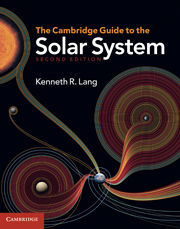Book contents
- Frontmatter
- Contents
- List of focus elements
- List of tables
- Preface to the second edition
- Preface to the first edition
- Principal units
- Part 1 Changing views and fundamental concepts
- Part 2 The inner solar system: rocky worlds
- 4 Restless Earth: third rock from the Sun
- 5 The Earth's Moon: stepping stone to the planets
- 6 Mercury: a dense battered world
- 7 Venus: the veiled planet
- 8 Mars: the red planet
- Part 3 The giant planets, their satellites and their rings: worlds of liquid, ice and gas
- Part 4 Remnants of creation: small worlds in the solar system
- Part 5 Origin of the solar system and extrasolar planets
- Author index
- Subject index
6 - Mercury: a dense battered world
from Part 2 - The inner solar system: rocky worlds
Published online by Cambridge University Press: 05 August 2011
- Frontmatter
- Contents
- List of focus elements
- List of tables
- Preface to the second edition
- Preface to the first edition
- Principal units
- Part 1 Changing views and fundamental concepts
- Part 2 The inner solar system: rocky worlds
- 4 Restless Earth: third rock from the Sun
- 5 The Earth's Moon: stepping stone to the planets
- 6 Mercury: a dense battered world
- 7 Venus: the veiled planet
- 8 Mars: the red planet
- Part 3 The giant planets, their satellites and their rings: worlds of liquid, ice and gas
- Part 4 Remnants of creation: small worlds in the solar system
- Part 5 Origin of the solar system and extrasolar planets
- Author index
- Subject index
Summary
• Because of its close proximity to the Sun, the innermost planet Mercury cannot be studied from Earth against the dark night sky; many astronomers and most people have never seen the elusive planet.
• During the daytime, Mercury's ground temperature reaches 740 kelvin, hot enough to vaporize water and melt lead; at night it plunges to a freezing 90 kelvin.
• Although Mercury is one of the Earth's nearest planetary neighbors, only two spacecraft have ventured near Mercury. They are the Mariner 10 spacecraft in 1974–75 and the MErcury Surface, Space ENvironment, GEochemistry, and Ranging (MESSENGER) spacecraft in 2008–11.
• There is a simple three-to-two resonance between Mercury's rotation period of 58.646 Earth days and its orbital year of 87.969 Earth days. This spin–orbit coupling is produced by solar tides in the solid planet.
• The interval from sunrise to sunset at a given location on Mercury is 87.969 Earth days, and the night lasts 87.969 Earth days more, so the day on Mercury lasts 175.938 Earth days and is twice Mercury's year.
• Mercury's rotation axis is aligned perpendicular to its orbital plane, so there are no seasons on the planet, and its polar regions never receive the direct rays of sunlight. Radar echoes suggest that water ice may reside in permanently shaded regions within deep craters near Mercury's poles.
• Mercury has highland craters and impact basins that resemble those found on the Moon. The craters and basins on both objects were most likely formed during a late heavy bombardment by meteorites 3.9 billion years ago. […]
- Type
- Chapter
- Information
- The Cambridge Guide to the Solar System , pp. 201 - 219Publisher: Cambridge University PressPrint publication year: 2011



